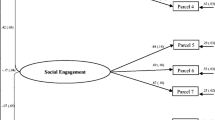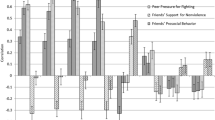Abstract
Peer and teacher perceptions of younger and older ADDH and normal children were compared. Peer nominations on the Pupil Evaluation Inventory revealed that ADDH children received more nominations on the Aggression factor and fewer on the Likability factor. ADDH boys received more nominations on the Withdrawal factor. Generally, older children received fewer nominations, but age did not interact with diagnosis; that is, younger and older ADDH children were perceived by peers as equally deviant. Discriminant analyses showed that peer ratings were useful in discriminating between ADDH and normal boys, but not between ADDH and normal girls. Teacher ratings of peer behavior suggested that older ADDH girls were perceived as less disturbed than younger girls. However, teacher ratings of boys revealed no age by diagnosis interactions. Low to moderate correlations were found between peer and teacher ratings of ADDH boys, and the pattern of relationship varied with age.
Similar content being viewed by others
References
Achenbach, T. M., & Edelbrock, C. S. (1981). Behavioral problems and competencies reported by parents of normal and disturbed children aged four through sixteen.Monographs of the Society for Research in Child Development, 46 (1, Serial No. 188).
American Psychiatric Association. (1980).Diagnostic and statistical manual of mental disorders (3rd ed.). Washington, D. C.: Author.
Campbell, S. B., & Paulauskas, S. (1979). Peer relations in hyperactive children.Journal of Child Psychology and Psychiatry, 20, 233–246.
Coie, J. D., Dodge, K. A., & Coppotelli, H. (1982). Dimensions and types of social status: A cross-age perspective.Developmental Psychology, 18, 557–579.
Conners, C. K. (1969). A teacher rating scale for use in drug studies with children.American Journal of Psychiatry, 126, 152–156.
Halliday, R., Callaway, E., & Naylor, H. (1983). Visual evoked potential changes induced by methylphenidate in hyperactive childen: Dose response effects.Journal of Electroencephalography and Clinical Neurophysiology, 55, 258–267.
Hartup, W. W. (1983). The peer system. In W. Mussen (Ed.),Handbook of child psychology (Vol. 4, pp. 103–196). New York: Wiley.
Johnston, C., Atkins, M. S., Pelham, W. E., & Crawford, J. (1983, June).A comparison of two sociometric instruments for the assessment of children’s social competence. Paper presented at the Canadian Psychological Association, Winnipeg, Canada.
Klein, A. R., & Young, R. D. (1979). Hyperactive boys in their classroom: Assessment of teacherand peer perceptions, interactions, and classroom behaviors.Journal of Abnormal Child Psychology, 7, 425–442.
LaGreca, A. M. (1981). Peer acceptance: The correspondence between children’s sociometric scores and teacher’s ratings of peer interactions.Journal of Abnormal Child Psychology, 9, 167–178.
Ledingham, J. E., Younger, A., Schwartzman, A., & Bergeron, G. (1982). Agreement among teacher, peer, and self-ratings of children’s aggression, withdrawal, and likability.Journal of Abnormal Child Psychology, 10, 363–372.
Mash, E. J., & Johnston, C. (1982). A comparison of the mother-child interactions of younger and older hyperactive and normal children.Child Development, 51, 1371–1381.
Mash, E. J., & Johnston, C. (1983). Sibling interactions of hyperactive and normal children and their relationship to reports of maternal stress and self-esteem.Journal of Clinical Child Psychology, 12, 91–99.
Milich, R., & Landau, S. (1982). Socialization and peer relations in the hyperactive child. In K. Gadow & I. Bialer (Eds.),Advances in learning and behavioral disabilities (Vol. 1, pp. 283–339). Greenwich, Connecticut: JAI Press.
Milich, R., Landau, S., Kilby, G., & Whitten, P. (1982). Preschool peer perceptions of the behavior of hyperactive and aggressive children.Journal of Abnormal Child Psychology, 10, 497–510.
Pekarik, E. G., Prinz, R. J., Liebert, D. E., Weintraub, S., & Neale, J. M. (1976). The Pupil Evaluation Inventory: A sociometric technique for assessing children’s social behavior.Journal of Abnormal Child Psychology, 4, 83–97.
Pelham, W. E. (1982a, August). Laboratory measures of attention in the diagnosis of hyperactivity-attention deficit disorder. In W. E. Pelham (Chair),Identification and diagnosis of children with attention deficit disorder-hyperactivity. Symposium conducted at the meeting of the American Psychological Association, Washington, D.C.
Pelham, W. E. (1982b). Childhood hyperactivity: Diagnosis, etiology, nature and treatment. In R. Gatchel, A. Baum, & J. Singer (Eds.),Behavioral medicine and clinical psychology: Overlapping disciplines (pp. 261–327). Hillsdale, New Jersey: Erlbaum.
Pelham, W. E., Atkins, M. S., & Murphy, H. A. (1981, September). ADD with and without hyperactivity: Parent, teacher, and peer rating correlates. In W. E. Pelham (Chair),DSM III category of attention deficit disorder: Rationale, operationalization, and correlates. Symposium conducted at the meeting of the American Psychological Association, Los Angeles.
Pelham, W. E., & Bender, M. E. (1982). Peer relationships in hyperactive children: Description and treatment. In K. Gadow & I. Bialer (Eds.),Advances in learning and behavioral disabilities (Vol. 1, pp. 365–435). Greenwich, Connecticut: JAI Press.
Pelham, W. E., Atkins, M. S., Murphy, H. A., & Swanson, J. (1984).A rating scale for the diagnosis of attention deficit disorder: Teacher norms, factor analysis, and reliability. Manuscript submitted for publication.
Singleton, L., & Asher, S. (1977). Peer preferences and social interaction among third-grade children in an integrated school district.Journal of Educational Psychology, 69, 330–336.
Weintraub, S., Prinz, R. J., & Neale, J. M. (1978). Peer evaluations of the competence of children vulnerable to psychopathology.Journal of Abnormal Child Psychology, 6, 461–473.
Whalen, C. K., Henker, B., Dotemoto, S., & Hinshaw, S. P. (1983). Child and adolescent perceptions of normal and atypical peers.Child Development, 54, 1588–1598.
Younger, A., Schwartzman, A. E., & Ledingham, J. E. (1982).Age-related changes in children’s perceptions of aggression and withdrawal in their peers (Research Bulletin, Vol. 1, No. 009). Montreal, Quebec: Concordia University.
Author information
Authors and Affiliations
Additional information
During the writing of this report, Charlotte Johnston was supported by a Sir James Lougheed Fellowship, Alberta Heritage Scholarship Fund.
Rights and permissions
About this article
Cite this article
Johnston, C., Pelham, W.E. & Murphy, H.A. Peer relationships in ADDH and normal children: A developmental analysis of peer and teacher ratings. J Abnorm Child Psychol 13, 89–100 (1985). https://doi.org/10.1007/BF00918374
Revised:
Published:
Issue Date:
DOI: https://doi.org/10.1007/BF00918374




